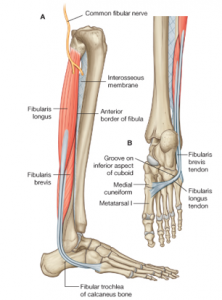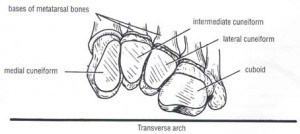The human foot has three arches—an inner arch, an outer arch and a transverse arch that spans the foot from side to side. The transverse arch is made up of the cuboid bone, the three cuneiform bones and the base of the metatarsal bones. The arches of the feet are all supported and strengthened by ligaments and fascia and the tone of a number of different muscles.
The interosseous, plantar, and dorsal ligaments of the foot aid the support of the transverse arch and along with the tone of the fibularis longus muscle, determine the ability of the arch to function in movement. If fibularis longus, and the aforementioned ligaments, are properly aligned and toned the transverse arch can work as designed.
When it comes to issues of the feet and their arches solutions are found in the muscles and ligaments. I wrote the other day about walking barefoot and I have written before about getting rid of orthotics. Both of these acts require walking correctly which will take care of almost every foot problem.
My work doesn’t really deal with ligaments beyond the fact that proper movement patterns will lead to happier ligaments because less stress will be put on all of our joints. But muscles are my game and when it comes to the transverse arch it is all about the fibularis longus. Fibularis longus begins just below the knee on the outer calf. It extends down the leg turning into a very long tendon that wraps around the ankle bone on its way under the foot. It passes through a groove in the cuboid bone before running under the cuneiform bones and attaching to the medial cuneiform and first metatarsal.
When fibularis longus is working correctly it provides the transverse arch with much of its required support. And it will also relieve stress that the aforementioned ligaments might be bearing. It has been my experience that most people need to work on their relationship to the fibularis muscles.
Anyone who walks on the outside of the foot, which is almost everyone, is not going to have happy fibularis muscles.
***


